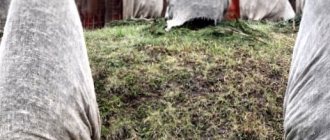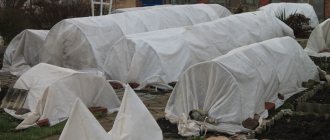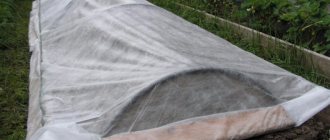Roses in winter need good protection from frost, cold, strong winds, and sudden temperature changes. The flower garden can withstand frosts down to -4 degrees, so bushes of cultivated plants should be protected from negative environmental conditions, otherwise in the spring the flowers may not produce full buds. Let's consider the rating of the best covering materials for roses.
Covering roses with spunbond
Spunbond is a polymer material that is partially permeable to oxygen, carbon dioxide and water. The product is sold at affordable prices and does not lose its properties during use at a temperature of minus 55 °C.
Bushes of single roses are wrapped on all sides with a product that is attached to metal arcs or pins. Spunbond is folded in 2-3 layers and covered with supports, creating a frame.
Black agrofibre is used to remove weeds. To avoid the germination of weeds near the roots of cultivated plants, it should be laid with spunbond on the surface of the ground.
Covering roses with polyethylene
Polyethylene is a cheap, universal material that does not allow moisture and cold air to pass under the structure. Unfortunately, today the product is experiencing low demand; more advanced thermal insulation products have appeared on the market.
The main disadvantage of polyethylene is that it does not allow oxygen to pass through, which is necessary for the full implementation of photosynthesis.
Carbon dioxide accumulates inside fences and greenhouses, which in high concentrations disrupts the connective tissue of plants, the leaves begin to rot and rot.
If you do not periodically ventilate the room, plants with limited access to oxygen will burn. Advantages: long service life, does not allow moisture or gusts of wind to pass through.
Covering roses with geotextiles
The product is a non-woven material with unique properties. All sizes are available for sale. After purchase, it is possible to sew several coatings together and use them without any expiration date.
Group seedlings of roses are covered with one product. For climbing flowers, covers are made that are fixed on supports, as a result of which in winter the mass of snow is evenly distributed over the surface of the material.
Geoxtiles are purchased in stores specialized in landscape design and construction. The complete set is presented in the form of rolls of any size. Ready-made covers for covering seedlings are also available for sale. Positive sides:
- Does not allow air to enter the structure.
- Duration of operation.
- Environmentally friendly, does not release toxic compounds into the environment.
- Frost resistance.
- No condensation is created during use.
Technology of covering with spruce branches
Before winter, roses are covered gradually, in several stages. The pruning procedure is required regardless of whether you are using spruce branches or synthetic non-woven material. Using a sharp pruning shears, cut the rose shoots to a height of 40-50 cm, no more. Then all the leaves are removed, covered with earth after the first frost and sprinkled with peat. When the air temperature drops below zero (-6-7°C), the top of the rose bushes is covered with coniferous spruce branches and dry leaves.
The use of spruce or pine branches is even allowed to cover climbing roses. To do this, the shoots do not need to be removed from the support; they are simply wrapped in branches, securing the latter with soft ropes.
Covering roses with lutrasil
The canvas is a durable product with a service life of several years. Main advantages:
- Does not absorb moisture.
- Partially breathable.
- No greenhouse effect is created.
To protect roses from exposure to low temperatures, it is necessary to use a white product as a coating, the density of which is 60 g/m². To do this, it is recommended to first fold the canvas in two layers.
The cost of 1 meter varies from 25-50 rubles. To cover flexible varieties, it is recommended to bend the roses, leaving a distance of 10-20 cm to the soil, after which it is necessary to install arcs and throw a cloth. Reinforce the sides with heavy objects: stones, beams, boards, studs.
Types of covering material
It is not recommended to use hay, manure, or straw to cover roses, as they tend to decompose quickly.
Lutrasil, spandbond, polyethylene, spruce branches, and dry leaves are recommended.
The following shelter options are available:
- Dry leaves and spruce branches . Using them as a covering material is considered the best and most inexpensive option. Spruce spruce branches can protect roses not only from cold wind, snow, frost, but also from rodents. Under its cover, sudden changes in temperature conditions for plants are invisible; it creates excellent ventilation inside the shelter. Harvesting branches is allowed only from felled trees in the sanitary cleaning zone or in other designated places. If the forest is very far away, it will be quite difficult to stock up on spruce branches. But there is a risk of infecting plants with various diseases and the site with pests. When walking through a pine forest, you must first take a closer look at the tree from which the spruce branches will be cut.
- Lutrasil . This is a relatively new material that has many advantages. Lutrasil is very wear-resistant; it can be used to cover plants for more than one year. Easy to store, after use it must be dried, rolled up and put away. Eco-friendly material (permeable to air and moisture) and affordable. The disadvantages include a low level of resistance to ultraviolet radiation.
- Geotextiles . Initially, this material was created for the construction industry, but due to its technological qualities and structure it is ideal for gardening. Not susceptible to rotting, excellent moisture and air permeability, affordable. No shortcomings were found in this material. To cover plants, it is better to purchase geotextiles with a density of 200 grams per square meter.
- Spandbond . This non-woven material is an alternative to the usual polyethylene film. Creates a favorable light regime for the plant and protects from direct sunlight. It allows moisture and air to pass through and prevents rodents and insects from entering the rose bushes. Wear-resistant, tolerates temperatures down to -55 degrees. The covering material has no negative reviews.
Construction of shelters using improvised means
To reduce the cost of purchasing expensive insulating materials, you can use your grandmother’s methods, for example, in the old days in Rus' they covered the garden with straw and felt window frames, thus the crop was protected from the effects of frost and hail.
You can use burlap, which is sold in any store in the form of rolls; it is recommended to use this type of fabric in the same way as modern products.
- Cons: dense material creates an excessive percentage of shadow.
- Advantages: does not allow moisture to pass through, optimal temperature is maintained under the surface.
To save on purchases, you can use bags of rice, sugar, cereals, flour; Jute or propylene trunks are suitable for use. The burlap is put on previously prepared bayonets, the soil is insulated with leaves or sawdust, and then hilled up.
How to prepare?
Full care of roses in the fall necessarily includes preparation for winter. It is usually carried out in September and October, before frost hits and the leaves from the plant have already fallen off. Where to start and what measures to take?
According to the recommendations of experienced gardeners, preparing roses for winter includes the following mandatory items.
- Apply potassium-phosphorus fertilizer to strengthen the root system.
- Pinch young shoots to prevent them from growing.
- Carry out pruning: sanitary (remove all damaged, weak, diseased shoots) and formative (give the bushes the desired shape).
- In October, remove the remaining leaves from the bushes, collect all plant debris from under them and burn them.
- After this, carry out preventive spraying with fungicidal and insecticidal solutions - against fungus and insects.
- In the north-west and central Russia, hill up so that the grafting site is below ground level. This should not be done in the southern regions, otherwise the roses will begin to rot and rot.
Recipes for fertilizing in September (consumption - 1 bucket for a rose garden with an area of 4 m2):
- a bucket of water, 15 g each of monopotassium phosphate and double superphosphate;
- bucket of water, 10 g of potassium sulfate, 25 g of double superphosphate, 2 g of boric acid.
What not to do starting in September:
- water;
- apply nitrogen fertilizers;
- loosen the soil.
One of the main points of preparation is wrapping the bushes so that they do not freeze.
How much frost can roses withstand without shelter?
The following numbers are relevant here:
- 10°C is the maximum constant temperature that roses can withstand in winter without shelter;
- 15°C - they will survive if this mark is maintained for no more than a day;
- 30°C - the bush freezes completely (with the exception of frost-resistant varieties).
However, you need to take into account that all these figures are averages and each variety reacts differently to frost. There are those who do not tolerate minus 5°C well, and some are not afraid of a constant minus 20°C. Therefore, it is strongly recommended to obtain this information about specific varietal species.
According to experts, even in the southern regions, where winters are usually warm, the bushes need to be slightly covered, since the root collar can freeze even at minus 3.5°C.
Products used in construction
After renovation or construction, there is always a mountain of rubbish that seems unnecessary at first glance. Things that can be ideally useful as improvised devices for insulating a flower garden: beams, boards, polyethylene, bags, slate, expanded clay.
Durable material - wood is used for the construction of small structures (houses) or to create a frame.
Small huts can be made from slate; roofing material is used as bedding; plant stems are placed on them. Instead of fastening structures, ropes, shreds, wires, pegs, stones, and pickets are used.
Lapnik
Unfortunately, spruce branches grow in certain areas, mainly in wild places. To cover large areas you will need a large number of branches. To protect low-growing crops, it is recommended to purchase spruce branches with a trunk diameter of 30 cm.
Attention, you can cover roses with spruce branches at temperatures below minus 6 degrees.
Leaves
Only dry raw materials can be used to insulate the root system of plants. It should be remembered that this option exposes the plant to the development of fungal diseases.
Sawdust
To properly protect the roots of roses from freezing, you should cover the earth's surface with sawdust material, on top of which hard objects (slate, brick, boards) are placed.
This type of system is used in the northern regions, areas of the country where long, harsh winters prevail. The following must not be added to the soil, sawdust: sand, fine fractions and substances containing chemicals, varnishes, materials previously used in furniture production.
Sawdust with a size of 10 mm or more is considered an excellent option, as it is not subject to caking, is hygroscopic, and has an antibacterial effect, which helps prevent the development of diseases.
Humus
A mixture of natural raw materials is used to mulch the soil. Rotten raw materials do not protect the root system from temperature changes. The vitamin composition should be pre-mixed with sawdust, this will create optimal looseness of the earth's surface.
Which insulation to choose
Like all beauties, the rose cannot withstand drought, wind, heavy rain and frost. An important condition for obtaining a healthy bush is the timely adoption of measures to protect the root system and shoots. Particular attention should be paid to the choice of covering material for the period of preparing the plant for wintering.
In order for the rose to successfully overwinter and actively begin to grow in the spring, you need to know what variety of flowers to choose for planting in open ground on your own plot. Experts recommend giving preference to zoned varieties that can withstand the climatic conditions of a particular area. It is also recommended to select the optimal covering material for roses for the winter, taking into account its aerobic characteristics and the type of plant.
Shelter stages
Experienced summer residents and gardeners have developed a simple technique that is used by millions of gardeners.
- Prepare each rose bush, cut off unnecessary, dead, diseased branches.
- Twist them a little and tie them to the previously prepared arches.
- Place roofing felt and fix polyethylene or other pre-purchased material on top. It is important to press the edges of the product tightly to prevent open spaces and cracks.
- Agronomists recommend creating a cushion of leaves or sawdust on the soil through which air will circulate.
When purchasing thermal insulation material, it is worth knowing that the thinner the product, the shorter its service life, up to 3-4 seasons. If you use the canvas correctly and carefully, you can extend the service life up to 6 years.
Repeated use involves carrying out disinfection procedures up to once a year; watch as they become dirty. The fact is that during application, pathogenic microorganisms accumulate on the surface of the product, which can destroy the flower garden.
Note, at the end of the preparatory stages for removing the material to the storage area, the canvas cannot be wrung out. It is recommended to store folded in a dark, cool place. The coating must not be removed abruptly.
In order for the plants to gradually adapt to light, temperature and humidity, it is necessary to open the end parts of the structure in late spring, otherwise the roses will lock up and die. You can completely empty the flower garden after the onset of warm weather and optimization of the temperature regime.
Rose and winter hardiness
The winter hardiness of roses depends on the species.
Some varieties in the middle zone do not need to be covered for the winter. In the Moscow region and other regions of the Central zone, modern hybrid forms of the Rugosa rose overwinter without problems. Canadian park roses are distinguished by high frost resistance:
- Adelaide Hoodless;
- Prairie Joy;
- Winnipeg Parks;
- Hope of Humanity.
Climbing roses are popular among gardeners. Some varieties tolerate frosts down to -30 °C (Alchemist, Hendel), others freeze out when the thermometer drops to -7 °C. Climbing roses of continuous flowering require good shelter for the winter:
- Lagoon;
- Parade;
- Paul Scarlett.
Most hybrid tea varieties cannot withstand frosty winters; they are easier to grow in the southern regions. They require mandatory shelter if the temperature drops to -20 °C in winter. Floribunda roses are frost-resistant, but in Siberia and the Urals they are covered for the winter.
When purchasing a seedling, you must check the frost hardiness zone (USDA). There are 13 of them and each has its own minimum temperature value. It is given without taking into account shelter. If there is a covering layer, roses can withstand frosts 5-10 ° lower than indicated in the recommendation.
What you need to know about roses
During the period of winter frosts, Rosaceae experience stress; in order not to freeze, the flowers release nutrients from the bottom to the top. There is no need to remove the leaves before covering; they help the plant survive the harsh winter, thus preparing the roses for exposure to low temperatures.
Some gardeners remove leaves to prevent the development of fungal microflora diseases. If there are spots of any color on the stems or leaves, it is necessary to tear off all the leaves from the bush and treat the plant with sulfur preparations or Bordeaux mixture.
When all the foliage has been removed, after trimming the bushes, you can spray with any sulfur preparation or copper sulfate.
It is better to do the procedure on a sunny, clear day, in calm weather. Leaves that have fallen on the ground must be removed in a plastic bag or burned. Leaves are a source of infection. In the process of pruning soft stems, it is necessary to avoid damage to the skin, otherwise infection can penetrate through the “wound”.
Beautiful flowers require proper care, care and attention, so you should fully comply with the frequency of grafting, the rules of hilling and covering the plant. If a rose is not cared for properly, it can turn into a rose hip.
How to properly cover roses for the winter
Most gardeners lovingly and skillfully care for the queen rose. However, the natural and climatic conditions are not always and not everywhere favorable for growing this wonderful flower. The arrival of winter is of particular concern to novice summer residents. What roses are recommended to be covered for the winter, the features of covering different varieties and varieties, the optimal timing, the subtleties of preparing roses for shelter, as well as the most rational methods, will be covered in our article.











